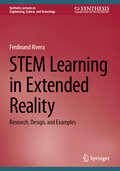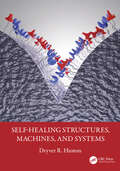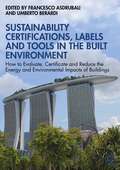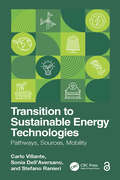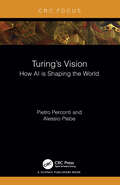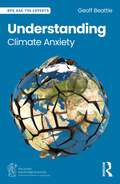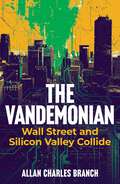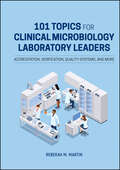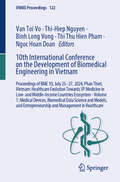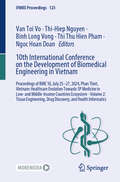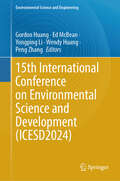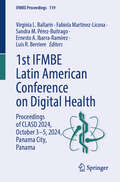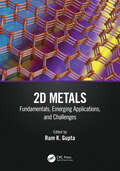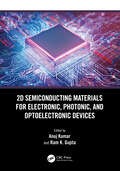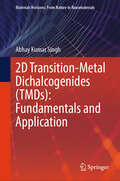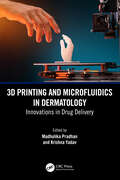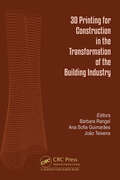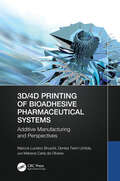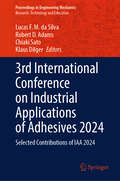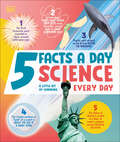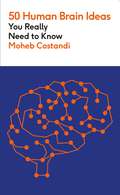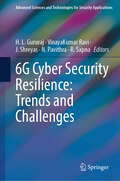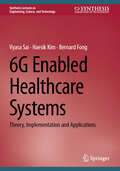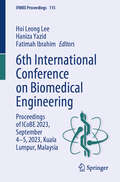- Table View
- List View
STEM Learning in Extended Reality: Research, Design, and Examples (Synthesis Lectures on Engineering, Science, and Technology)
by Ferdinand RiveraThis book synthesizes findings from recent and ongoing research on the use of Extended Reality (XR) to support learning of STEM content. XR is slowly being introduced in classrooms due to significant changes in XR technology. These tools were historically costly, unfriendly, and developed only for gamers. Today, XR tools are able to enhance students’ immersive experiences in such settings. In classrooms, in particular, they provide learners with an opportunity to manipulate abstract objects as if they are physical objects. The book begins with an extensive and detailed description and evaluation of the impact of various XR interventions on learning and engagement in STEM classrooms. The author then concludes with theoretical frameworks for investigating learning in computer- immersive contexts and practical implications for effectively using XR tools to learn STEM.
Self-Healing Structures, Machines, and Systems
by Dryver R. HustonThis book describes the behavior, underlying principles and design of self-healing materials, structures, machines, and systems. Self-healing is a ubiquitous phenomenon that appears in many systems ranging from the molecular scale up through to large macroscale systems and in domains ranging from materials such as self-healing polymers, to self-sealing tires, water distribution networks, and information systems, including control systems for damaged aircraft. Self-healing extends performance and endurance in ways that are just not possible otherwise. This book presents a unifying holistic approach to the operation and design of self-healing systems. It acts as a valuable reference for students, researchers, and engineers that are interested in understanding self-healing mechanisms and acquiring techniques to extend the performance and endurance of the structures, machines, and systems that they build, design, and study.Key Features: Describes the design, operating principles, manufacture and performance assessment of self-healing materials, structures, machines, and systems. Presents a unique holistic approach to the engineering and inclusion of self-healing into structures, machines, and systems. Topics covered includes materials, machines, vessels, structures, networks, and systems, with detailed discussions of polymers, concrete, machinery, pressure vessels, fuel tanks, knives, clothing, lasers, biohybrids, networks, and information systems.
Sustainability Certifications, Labels and Tools in the Built Environment: How to Evaluate, Certificate and Reduce the Energy and Environmental Impacts of Buildings
by Umberto Berardi Francesco AsdrubaliThis book is aimed at covering all aspects of the evaluation, certification, and reduction of the energy and carbon footprint of the built environment from the scale of the city and its neighbourhoods, to the building level and finally to the level of single building materials and components. Many protocols, tools, and labels have been proposed in recent years, both at international and local levels, and the aim of the book is to classify, describe, and discuss all the different approaches and options.The chapters offer a comprehensive, up-to-date, and critical review of all the different certification methods that have been proposed at different levels in the building sector. The first chapter introduces the topic and its importance, providing data on the impact of the building sector and the construction industry. The following chapters are dedicated respectively to tools and protocols for cities and neighbourhood sustainability assessment, tools and protocols for buildings sustainability assessment and certification, and for building materials and components. Finally, this book includes an overview of the legislation and standards in the field and case studies to exemplify the application of the different tools and labels.This is a key reference for decision-makers, researchers, scholars, students, and professionals approaching research and work in the field of energy and environmental impact of the building sector be they engineers, architects, planners, owners, developers, or facility managers.
Transition to Sustainable Energy Technologies: Pathways, Sources, Mobility
by Carlo Villante Sonia Dell'Aversano Stefano RanieriThis book explains the challenges related to global energy transition, focusing on decarbonization, renewable technologies, and sustainable mobility. It offers a comprehensive exploration of integrated socio-economic, environmental, and technological perspectives and provides actionable solutions and practical pathways for transitioning to sustainable energy systems. Designed to be used in short academic courses, this textbook is an excellent foundational text for upper-level undergraduate and graduate students in engineering and environmental sciences taking specialized courses in energy systems, renewable technologies, climate change mitigation, and environmental impacts. It is also a great resource for professionals and policy makers involved in energy projects.Features: Offers an interdisciplinary approach to energy transitions combining theoretical frameworks with practical applications. Explores the full spectrum of energy systems, comparing conventional to renewable sources, energy vectors, and energy-storage technologies. Incorporates real-world data from leading institutions and integrates key historical milestones like the Paris Agreement with forward-looking trends. Highlights cutting-edge innovations, including solar and wind energy, hydrogen, energy-storage systems, synthetic fuels, and smart grids, and emphasizes their integration into energy systems and sustainable mobility solutions. Bridges the gap between socio-economic, environmental, and technological perspectives. The Open Access version of this book, available at http://www.taylorfrancis.com, has been made available under a Creative Commons Attribution-Non Commercial-No Derivatives (CC BY-NC-ND) 4.0 license.
Turing's Vision: How AI is Shaping the World
by Pietro Perconti Alessio PlebeChat-GPT, humanoid robotics, and self-driving cars are just a few of the things that are changing our everyday lives. The rapid advancement of AI is eroding one by one all the cornerstones considered unique of human nature: language, consciousness, creativity, and moral responsibility. The book argues that the revolution we are facing is driven by Alan Turing's "vision". This vision rests on the idea that intelligence is not an intrinsic property of human beings, but is a way in which matter is functionally organized and an attribute we are naturally inclined to ascribe to certain entities. For decades we have pretended that this idea does not have the corrosive power that it actually does, perhaps more so than the Copernican and Darwinian revolutions. But now, given the achievements of new forms of computing based on deep learning and predictive coding, the most common intuitions can no longer avoid the dangerous Turing idea.The book is intended for scholars, researchers, and readers intrigued by the intersections across disciplines interested in understanding the philosophical, ethical, and social implications of Artificial Intelligence and its impact on human nature.
Understanding Climate Anxiety (BPS Ask The Experts in Psychology Series)
by Geoff BeattieHow should we react to climate anxiety? This accessible book discusses anxiety and other emotions brought on by climate change, examining what climate anxiety is, why it is becoming so prevalent and how it differs from other types of anxiety.Written by an expert psychologist, the book examines why climate anxiety is developing so rapidly, particularly in younger people. It looks at how it can manifest differently—sometimes as hopelessness or despair, and sometimes as anger which can serve as a catalyst for action. The book dives into the nuance around climate anxiety, questioning what we can do about it or whether climate anxiety should be pathologized at all, given the very real threat of climate change. It considers cognitive biases that underlie information processing and discusses how politics and interest groups affect people’s views. Seeking to understand the polarisation that occurs around this topic, the book suggests how we might alleviate climate anxiety without minimising serious concern about climate change.This highly topical book will be of great interest to students of psychology, environmental science and social science. It will also be of interest to psychologists, mental health professionals and climate communicators, as well as anyone interested in learning more about climate anxiety.
The Vandemonian: Wall Street and Silicon Valley Collide
by Allan Charles Branch"A memoir that is as much about human frailty as it is about achievement." In his remarkable memoir, Allan Charles Branch invites readers on an unpredictable global journey from an &‘unremarkable&’ Tasmanian boy to a revolutionary force in multiple industries. He defied the odds to innovate technologies and resurrect failing companies worldwide. Allan's early years in Tasmania were spent navigating government, business, and education as he sought to discover who he wasn&’t. This journey led to a bold leap into entrepreneurship, where he established Tasmania&’s first high-tech company. Relocating to Silicon Valley, he mingled with industry legends like Steve Wozniak and Isaac Asimov, pushing the boundaries of robotics and business. By the time he stepped away, he had possibly designed, built, and sold more intelligent robots than anyone else, redefining his identity as an inventor and entrepreneur. But Allan&’s journey didn&’t end there. He embarked on a new chapter as a transformational leader, traveling the globe to rescue seemingly irredeemable companies using innovative problem-solving techniques honed through years of experience. Along the way, he not only revived businesses but also saved countless jobs and livelihoods. Through these experiences, Allan reflects on the personal toll of his relentless career, navigating the complexities of success, loneliness, and self-discovery. Told through vivid vignettes, The Vandemonian captures Allan&’s extraordinary journey of invention and transformation—revealing the man behind the robots. Blending the introspective depth of Paul Auster&’s Winter Journal with the transformative arc of Frank McCourt&’s Angela&’s Ashes, The Vandemonian is a compelling narrative of human ingenuity and perseverance.
101 Topics for Clinical Microbiology Laboratory Leaders: Accreditation, Verification, Quality Systems, and More (ASM Books)
by Rebekah M. MartinSuccessfully manage your laboratory accreditation and compliance audits with this easily accessible how-to resource for clinical laboratories 101 Topics for Clinical Microbiology Laboratory Leaders: Accreditation, Verification, Quality Systems, and More by Rebekah M. Martin is your roadmap to achieving and maintaining excellence in clinical microbiology laboratory administration. This quick reference guide is designed to help laboratory professionals efficiently navigate the key aspects of accreditation, regulatory compliance, and quality management. This practical resource is perfect for both new and experienced laboratory leaders who need accessible, actionable information. Inside, you’ll find: Regulatory Overview: Information on the Clinical Laboratory Improvement Amendments, test complexity categories, and the roles of key agencies like the Centers for Medicare & Medicaid Services, the Centers for Disease Control and Prevention, and the Food & Drug Administration in overseeing clinical laboratories.Accreditation Basics: Guidance on how to obtain and maintain laboratory accreditation, including what to expect during inspections and how to respond to deficiencies.Test Verification & Validation: Essential tips on conducting verification and validation studies to ensure your laboratory’s test systems are accurate, reliable, and compliant with regulatory standards.Quality Management Essentials: Practical strategies for implementing and maintaining a quality management system, including process control, document management, and continuous improvement techniques that keep your lab running smoothly. Presented in a user-friendly question-and-answer format, 101 Topics for Clinical Microbiology Laboratory Leaders is your go-to resource for quick, reliable guidance on leading a compliant and high-performing clinical microbiology laboratory.
10th International Conference on the Development of Biomedical Engineering in Vietnam: Proceedings of BME 10, July 25-27, 2024, Phan Thiet, Vietnam: Healthcare Evolution Towards 5P Medicine in Low- and Middle-Income Countries Ecosystem - Volume 1: Medical Devices, Biomedical Data Science and Models, and Entrepreneurship and Management in Healthcare (IFMBE Proceedings #122)
by Thi-Hiep Nguyen Van Toi Vo Binh Long Vong Thi Thu Hien Pham Ngoc Hoan DoanThis book presents cutting-edge research and developments in the field of biomedical engineering, with a special emphasis on results achieved in Vietnam and neighboring low- and middle-income countries. Gathering the first volume of the proceedings of the 10th International Conference on The Development of Biomedical Engineering in Vietnam, BME 10, held on July 25-27, 2024, in Phan Thiet, Vietnam, reports on the design, fabrication, and application of low-cost and portable medical devices, biosensors, and microfluidic devices, on improved methods for biological data acquisition and analysis, including applications of artificial intelligence. It also discusses strategies to address some relevant issues in biomedical education and entrepreneurship. A special emphasis is given to advances promoting Healthcare Evolution towards 5P Medicine in Low- and Middle-Income Countries Ecosystem. All in all, this book offers important answers to current challenges in the field and a source of inspiration for scientists, engineers, and researchers with various backgrounds working in different research institutes, companies, and countries.
10th International Conference on the Development of Biomedical Engineering in Vietnam: Proceedings of BME 10, July 25-27, 2024, Phan Thiet, Vietnam: Healthcare Evolution Towards 5P Medicine in Low- and Middle-Income Countries Ecosystem - Volume 2: Tissue Engineering, Drug Discovery, and Health Informatics (IFMBE Proceedings #123)
by Thi-Hiep Nguyen Van Toi Vo Binh Long Vong Thi Thu Hien Pham Ngoc Hoan DoanThis book presents cutting-edge research and developments in the field of biomedical engineering, with a special emphasis on results achieved in Vietnam and neighboring low- and middle-income countries. Gathering the second volume of the proceedings of the 10th International Conference on The Development of Biomedical Engineering in Vietnam, BME 10, held on July 25-27, 2024, in Phan Thiet, Vietnam, it describes advances in molecular and cellular biology techniques, neuroengineering techniques, and statistical and computational methods, for different biomedical applications, such as drug delivery, medical diagnosis and monitoring. A special emphasis is given to advances promoting Healthcare Evolution towards 5P Medicine in Low- and Middle-Income Countries Ecosystem. All in all, this book offers important answers to current challenges in the field and a source of inspiration for scientists, engineers, and researchers with various backgrounds working in different research institutes, companies, and countries.
15th International Conference on Environmental Science and Development (Environmental Science and Engineering)
by Peng Zhang Gordon Huang Yongping Li Ed McBean Wendy HuangThis book is proposed to be a collection of excellently peer-reviewed research from the 2024 15th International Conference on Environmental Science and Development (ICESD 2024), which will be held during August 7-9, 2024 in Calgary, Canada. ICESD 2024 will gather innovative academics and industrial experts to a common forum to facilitate the exchange of scientific information and its application in the field of Environmental Science and Sustainable Development. Particularly, a large amount of the research is related to the Water Governance Programme which is an initiative as developed by the China International Center for Economic and Technical Exchanges, United Nations Development Programme, and Coca- Cola China. Recently, effects of energy crisis, water scarcity, environmental pollution, climate change, pandemic, and their interactions on eco-environment and health have caused extraordinary risks in socio-economic and environmental systems (SEE). Such risks feature dynamic, uncertain and interactive characteristics. In order to tackle these risks, cutting-edge technologies, including both experimental approaches and modeling ones, are desired urgently. Particularly, nature-based solutions will be developed to help achieve net-zero emission and United Nations Sustainable Development Goals. In addition, data-driven and AI-based methodologies will be developed to facilitate policy analysis of SEE under New Normal scenarios. Furthermore, the combinations of multiple approaches are expected to support the enhancement of SEE resilience in a post- pandemic future. Consequently, ICESD 2024 will include presentations in the field of Water Resources Management, Wastewater Treatment, Drinking Water Safety, Energy and Environmental systems Analysis, Air Pollution Control, Solid Waste Management, Sustainable Development, Ecosystem Restoration, Climate change adaptation, and Socio-Economic and Environmental Management. Excellent papers related to these topics would be enclosed in this proposed book.
1st IFMBE Latin American Conference on Digital Health: Proceedings of CLASD 2024, October 3-5, 2024, Panama City, Panama (IFMBE Proceedings #119)
by Virginia L. Ballarin Ernesto A. Ibarra-Ramírez Sandra M. Pérez-Buitrago Luis R. Berriere Fabiola Martinez-LiconaThis book reports on the latest research and developments in Biomedical Engineering, with a special emphasis on topics of interest and findings achieved in Latin America. It covers applications of artificial intelligence in medical diagnosis, cutting-edge biosignal processing methods, machine learning models in healthcare, and new technologies for medical rehabilitation and diagnosis. Based on the 1st Latin American Conference on Digital Health (CLASD 2024), held on October 3-5, 2024, in Panama City, Panama, this book provides researchers and professionals with extensive information on new technologies for healthcare and current challenges for their clinical applications.
2D Metals: Fundamentals, Emerging Applications, and Challenges
by Ram K. Gupta2D Metals: Fundamentals, Emerging Applications, and Challenges delves into the state-of- the-art advancements in utilizing 2D metals for emerging applications, encompassing a comprehensive overview of synthetic methodologies and characterization techniques provided by leading experts in the field.2D nanomaterials have emerged as highly promising candidates for a diverse array of cutting-edge applications, spanning energy and biomedicine, owing to their adjustable electrochemical properties, versatility, and exceptional mechanical resilience. Notably, carbon-based 2D materials have already demonstrated extensive utility across various domains. Meanwhile, 2D metals, often referred to as Metallenes, represent a burgeoning class of materials with broad reaching potential. In contrast to alternative 2D materials like graphene and transition metal chalcogenides, as well as bulk metals, 2D metals exhibit remarkable conductivity, expansive surface area, and customizable electronic and optoelectronic characteristics.This book explores the influence of structural modifications on the properties of 2D metals and addresses the myriad challenges associated with their burgeoning applications. Each chapter, authored by esteemed specialists from across the globe, offers invaluable insights, rendering this book an indispensable resource for students while furnishing researchers and industry professionals with novel guidance and perspectives.
2D Semiconducting Materials for Electronic, Photonic, and Optoelectronic Devices
by Anuj Kumar Ram K. GuptaTwo-dimensional semiconducting materials (2D-SCMs) are the subject of intensive study in the fields of photonics and optoelectronics because of their unusual optical, electrical, thermal, and mechanical properties. The main objective of 2D Semiconducting Materials for Electronic, Photonic, and Optoelectronic Devices is to provide current, state-of-the-art knowledge of two-dimensional semiconducting materials for various applications. Two-dimensional semiconducting materials are the basic building blocks for making photodiodes, light-emitting diodes, light-detecting devices, data storage, telecommunications, and energy-storage devices. When it comes to two-dimensional semiconducting materials, electronic, photonic, and optoelectronic applications, as well as future plans for improving performance, no modern book covers as much ground. The planned book will fill such gaps by offering a comprehensive analysis of two-dimensional semiconducting materials. This book covers a range of advanced 2D materials, their fundamentals, and the chemistry for many emerging applications. All the chapters are covered by experts in these areas around the world, making this a suitable textbook for students and providing new guidelines to researchers and industries. • Covers topics such as fundamentals and advanced knowledge of two-dimensional semiconducting materials • Provides details about the recent methods used for the synthesis, characterization, and applications of two-dimensional semiconducting materials • Covers the state-of-the-art development in two-dimensional semiconducting materials and their emerging applications This book provides directions to students, scientists, and researchers in semiconductors and related disciplines to help them better understand the physics, characteristics, and applications of 2D semiconductors.
2D Transition-Metal Dichalcogenides (Materials Horizons: From Nature to Nanomaterials)
by Abhay Kumar SinghThis book offers to reader a sound understating of two-dimensional Transition-Metal Dichalcogenides (2D TMDs) materials, detailing their physio-chemical mechanisms and technological applications in various areas such as nanoelectronics and optoelectronics. Moving from their invention to their modern developments, including theoretical approaches, experimental interpretations and their technical applications, the book explores the basic concepts of 2D TMDs. It will be of interest to undergraduate and postgraduate students, researchers and scientists working in the area of 2D TMDs. A key goal of this book provides a sound or clear idea about two-dimensional Transition-Metal Dichalcogenides (2D TMDs) materials by providing their sound background, fabrication approaches including interpretations of the inside physio-chemical mechanism including technological applications in various significant areas such as nanoelectronics, optoelectronics, topological insulators, biomedical.
3D Printing and Microfluidics in Dermatology: Innovations in Drug Delivery
by Madhulika Pradhan Krishna Yadav3D Printing and Microfluidics in Dermatology provides a thorough exploration and applications of three-dimensional (3D) printing and microfluidics within the field of dermatology. It investigates various methods utilized in these fields, such as 3D bioprinting, nano-transporters, microscopic fabrication, and device development.The book not only examines practical applications but also delves into the design principles crucial for implementing these techniques using specific materials tailored to their intended purposes. Additionally, it addresses ethical concerns and regulatory considerations pertinent to these evolving technologies.Key highlights include the following: A detailed insight into the utilization of 3D printing and microfluidic technologies for treating skin disorders. Exploration of design concepts necessary for effective implementation, considering the unique properties of materials involved. Coverage of diverse methodologies, ranging from 3D bioprinting to nano-transporters, microscopic fabrication, and device engineering. In-depth discussion on ethical considerations vital for the sustainable development of the industry. Investigation into advancements in material development, device design, fabrication techniques, and performance evaluation through preclinical and clinical studies. This book targets graduate students and researchers in fields such as 3D printing, dermatology, drug delivery, bioengineering, and pharmaceutical sciences.
3D Printing for Construction in the Transformation of the Building Industry
by Ana Sofia Guimarães Bárbara Rangel João TeixeiraAs concrete revolutionised construction in the 20th century, digitalisation is transforming the building industry (BI). Process automation and 3D printing (3DP) are commonplace in the industry and our homes. However, due to BI’s scale and complexity, Additive Manufacturing (AM) is in its native stage. Ongoing scientific research has been providing knowledge that will simplify the integration of 3DCP in the market, exploring its materiality, technologies, and design methodologies. This book provides an overview of the latest research achievements of the design possibilities that 3DP for construction (3DC) can offer in the various fields of construction, particularly architecture and engineering.
3D/4D Printing of Bioadhesive Pharmaceutical Systems: Additive Manufacturing and Perspectives
by Marcos Luciano Bruschi Denise Tiemi Uchida Mariana Carla de OliveiraThis book features a brief history of additive manufacturing and 3D/4D printing techniques, as well as the advantages, applications, and overall challenges facing the technology. It then focuses on the applications of bioadhesive systems for drug delivery.3D/4D Printing of Bioadhesive Pharmaceutical Systems: Additive Manufacturing and Perspectives, explores recent discoveries of 3D printing in the development of pharmaceutical systems and drug delivery. Specifically, it discusses the main polymers/materials used in the development of bio-adhesive pharmaceutical systems and explains the importance of bio-adhesiveness of drug release through 3D printing. The authors also introduce the main strategies necessary to achieve a proper drug delivery system through 3D printing, and examine the adhesiveness of these systems on the skin as the mucosa decreases with the elimination of the drug by the body. Finally, the book brings all the necessary specifications to obtain a bioadhesive system with suitable bio-ink to obtain the best 3D/4D printing.This book is written with the objective of helping students start their studies in pharmaceutical engineering, bioengineering and additive manufacturing. Moreover, engineering professionals can use the book to improve the performance of 3D/4D printers for this type of system.
3rd International Conference on Industrial Applications of Adhesives 2024: Selected Contributions of IAA 2024 (Proceedings in Engineering Mechanics)
by Robert D. Adams Chiaki Sato Lucas F. M. da Silva Klaus DilgerThis book offers selected papers presented at the 3rd International Conference on Industrial Applications of Adhesives, held in Cascais, Portugal, March 7-8, 2024. The goal of the conference was to provide a unique opportunity to exchange information, present the latest results as well as to discuss issues relevant to industrial applications of adhesives. Special contributions on formulation of adhesives, pressure sensitive adhesives, adhesive properties, design of adhesive joints, and durability of adhesive joints have been selected for this volume. This work will appeal to a wide readership, from practitioners through graduate students to researchers working in this field.
5 Facts a Day Science: A Little Bit of Learning Every Day
by DKAre you ready to have your mind blown? Wow all your friends and family with 5 jaw-dropping facts about science each day.Discover 5 facts a day, 5 days a week with this exciting science book for children aged 8-12. With five facts a day, every day of the year, that’s more than 1,825 nuggets of knowledge!From rocks to robots, and cells to solar systems, this eye-opening book covers more than 250 different science topics in an easy-to-read, entertaining, and bite-sized way to build on your knowledge as you go. Enjoy learning something new every day or just dip in and out for fun.This science book for children offers: An engaging layout, with different subjects and facts to explore every day.More than 250 different science topics, from electromagnetism to evolution.Fun, educational content for children to have fun whilst learning about science.Did you know that you can't burp in space? Or that bananas are slightly radioactive? Or that there are more trees on Earth than there are stars in our solar system? Discover the science behind all these facts and much more with 5 Facts a Day: Science.
50 Human Brain Ideas You Really Need to Know (50 Ideas You Really Need to Know series)
by Moheb CostandiMaster the ideas central to understanding the human brain.In a series of 50 accessible essays, Mo Costandi introduces and explains all we know about the brain and how it works, outlining both long-standing theories and cutting-edge ideas.From the function of neurons and synaptic transmission, to the nervous system and personality, 50 Human Brain Ideas You Really Need to Know is a complete introduction to the most powerful and mysterious organ in the body.
50 Human Brain Ideas You Really Need to Know (50 Ideas You Really Need to Know series)
by Moheb CostandiMaster the ideas central to understanding the human brain.In a series of 50 accessible essays, Mo Costandi introduces and explains all we know about the brain and how it works, outlining both long-standing theories and cutting-edge ideas.From the function of neurons and synaptic transmission, to the nervous system and personality, 50 Human Brain Ideas You Really Need to Know is a complete introduction to the most powerful and mysterious organ in the body.
6G Cyber Security Resilience: Trends and Challenges (Advanced Sciences and Technologies for Security Applications)
by H. L. Gururaj J. Shreyas VinayaKumar Ravi N. Pavithra R. SapnaThis book offers a comprehensive analysis of intersection of significant domains, including information security, 6G technology, and cybersecurity. This reference work addresses gaps in existing literature by providing insights, research findings, and personal evaluations from esteemed scholars in the field. Holographic-type communications (HTC), tactile Internet, connected autonomous vehicles (CAVs), unmanned aerial vehicles (UAVs), autonomous healthcare solutions, manufacturing systems, and virtual/augmented/extended reality (VR/AR/XR), along with other cutting-edge applications, will continue to advance with the advent of 6G. The advent of the 6G era has been ushered in by the rapid advancement of communication technologies, promising unprecedented applications and connectivity. As we venture into this unexplored domain, the criticality of cybersecurity resilience cannot be overstated. This book examines and assesses the emerging trends in 6G technology, with a particular focus on the intricate challenges encountered in the realm of cybersecurity. By analyzing the intricate interplay between IoT integration, AI/ML security, quantum communication, and the intricacies of the physical layer, this book endeavors to provide a comprehensive understanding of the perpetually evolving threat landscape. It is reasonable to expect that 6G, similar to its predecessors, will promote advancements in the domain of connectivity and telecommunications through the provision of increased data throughput, decreased latency, and expanded capacity. These developments will promote the development of innovative applications and services, thus increasing the importance of robust cybersecurity protocols. As 6G technology continues to proliferate, it becomes increasingly vital to ensure the security and preservation of data. The primary audience of this book is industrialists, academicians, researchers, and UG/PG students. The secondary audience consists of practitioners, cyberpolice, lawmakers, legal firms, etc. as we are also covering regulatory and ethical considerations in 6G cybersecurity.
6G Enabled Healthcare Systems: Theory, Implementation and Applications (Synthesis Lectures on Engineering, Science, and Technology)
by Bernard Fong Haesik Kim Vyasa SaiThis book introduces 6G enabled healthcare systems and helps readers understand state-of-the-art techniques and applications for future healthcare systems. Readers will be able to obtain a background knowledge about AI, wireless systems, implementation methods, and applications, enabling the upcoming migration from 5G to 6G for supporting mission-critical healthcare applications.
6th International Conference on Biomedical Engineering: Proceedings of ICoBE 2023, September 4–5, 2023, Kuala Lumpur, Malaysia (IFMBE Proceedings #115)
by Fatimah Ibrahim Hoi Leong Lee Haniza YazidThis book gathers the proceedings of the 6th International Conference on Biomedical Engineering (ICoBE 2023), which was held on September 4-6th, 2023, in a hybrid form, in Kuala Lumpur, Malaysia. The sixty-five peer-reviewed papers included here cover a diverse range of topics such as bioinstrumentation and biomedical devices, biomedical signal and image processing, artificial intelligence, bioinformatics and Internet of Things (IoT) in healthcare, as well as biomaterials, biomechanics and rehabilitation, and report on both theoretical and practical findings, achieved in different countries (including Philippines, Indonesia, Japan, United Arab Emirates, and Italy) besides Malaysia. Addressing an interdisciplinary audience of engineers, physicists, scientists, and researchers, this book offers extensive information on the current role and challenges of computer methodologies, artificial intelligence and machine learning in healthcare, together with strategies to improve healthcare through innovation. It truly reflects the theme of the 6th conference edition namely “Be the Change: The Key to Better Healthcare Quality”.
